B.1. Class Diagrams
A UML class diagram summarizes features of a class, its relation to other classes, or both. Beginning with an example, Figure B-1 shows the Starship class.
Figure B-1. UML class diagram summarizing the Starship class.
(This item is displayed on page 544 in the print version)
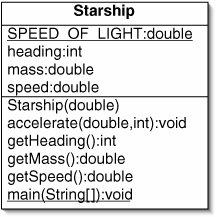
The diagram of a class is divided into three sections. The top section shows the name of the class in bold type. The middle section shows the fields of the class. The bottom section shows the methods of the class.
The name and type of each field are given, separated by a colon. A static field, such as SPEED_OF_LIGHT, is underlined.
In the methods section, the name, argument types, and return type of each method are given. In Figure B-1, the method accelerate() takes a double and an int as argument, but has a return type of void. Constructors have no return type. Static methods, like main(), are underlined.
UML class diagrams can also be used to show the relationships between classes. In Figure B-2, a Fleet contains zero or more Starships. If a Fleet always contained three to six Starships, the notation 0..* would be replaced with 3..6.
Figure B-2. UML class diagram showing the relationships between the Fleet, Starship, and Battlecruiser classes. The notation 0..* indicates any number that is at least zero.
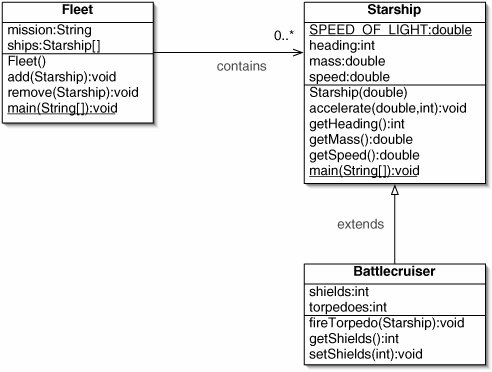
Figure B-2 also shows that the class Battlecruiser extends the class Starship. In other words, Battlecruiser is a direct subclass of Starship. This is explained in much more detail in Chapter 3. In a UML class diagram, any fields or methods present in the superclass are normally not listed in the subclass.
The words "contains" and "extends" are not normally included in UML class diagrams. Instead, the different arrow styles indicate the relationship in question. A line arrowhead indicates a "contains" or "has-a" relationship. A hollow arrowhead indicates an "is-a" relationship, such as "extends."
When there are many classes involved, it is sometimes clearer to leave out some or all of the fields and methods (Figure B-3).
Figure B-3. Fields and methods are sometimes omitted in UML class diagrams.
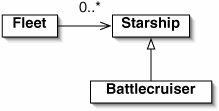
Interfaces (Section 2.3) can also be shown in UML class diagrams (Figure B-4). An interface name is labeled with the notation <>. A dashed arrow with a hollow head indicates an "implements" relationship, which is another kind of "is-a" relationship.
Figure B-4. The interface Animal is implemented by the classes Reptile and Mammal, which are extended by other classes.
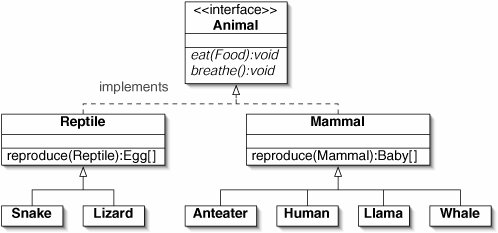
The methods in an interface are in italics to indicate that they are abstract. In other words, only the method signatures are specified in the interface; it is up to subclasses to provide concrete implementations. An abstract class (Section 5.5) can contain both abstract and concrete methods. In a UML class diagram, the name of an abstract class is italicized (Figure B-5).
Figure B-5. The class Organization is abstract, as is its method chooseNewLeaders(). A Corporation may have other corporations as subsidiaries. A Nation has at least one PoliticalParty, and may have other Nations as neighbors.
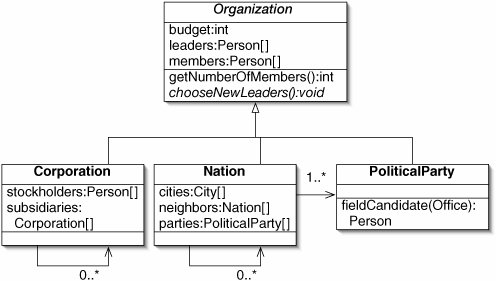
Java 1.5 introduces the notion of generic types (Section 4.1). A generic type has one or more other types as parameters. For example, a generic List type allows us to distinguish between a List of Integers and a List of Strings. In a UML class diagram, a type parameter is shown as a small, dashed box at the upper right of a class or interface (Figure B-6). This may contain either a type variable (such as E for element) or the name of a specific class.
Figure B-6. The Sequence class (top) is generic. A Poem (bottom) contains a Sequence of Words.
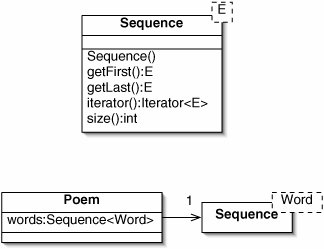
In very large programs, classes are often grouped into packages (Section 3.3). In a UML class diagram, a package looks something like a file folder drawn behind the classes it contains (Figure B-7).
Figure B-7. The game.ai package contains an interface and two classes. Each of the other two packages contains three classes.
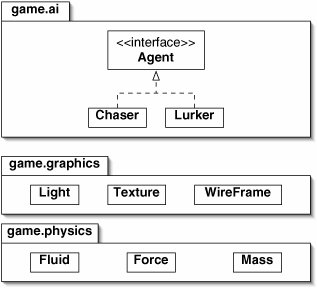
B 2 Instance Diagrams |
Part I: Object-Oriented Programming
Encapsulation
Polymorphism
Inheritance
- Inheritance
- Extending a Class
- The Object Class
- Packages and Access Levels
- Summary
- Vocabulary
- Problems
- Projects
Part II: Linear Structures
Stacks and Queues
- Stacks and Queues
- The Stack Interface
- The Call Stack
- Exceptions
- The Queue Interface
- Summary
- Vocabulary
- Problems
- Projects
Array-Based Structures
- Array-Based Structures
- Shrinking and Stretching Arrays
- Implementing Stacks and Queues
- The List Interface
- Iterators
- The Java Collections Framework: A First Look
- Summary
- Vocabulary
- Problems
- Projects
Linked Structures
- Linked Structures
- List Nodes
- Stacks and Queues
- The LinkedList Class
- The Java Collections Framework Revisited
- Summary
- Vocabulary
- Problems
- Projects
Part III: Algorithms
Analysis of Algorithms
- Analysis of Algorithms
- Timing
- Asymptotic Notation
- Counting Steps
- Best, Worst, and Average Case
- Amortized Analysis
- Summary
- Vocabulary
- Problems
- Projects
Searching and Sorting
- Searching and Sorting
- Linear Search
- Binary Search
- Insertion Sort
- The Comparable Interface
- Sorting Linked Lists
- Summary
- Vocabulary
- Problems
- Projects
Recursion
- Recursion
- Thinking Recursively
- Analyzing Recursive Algorithms
- Merge Sort
- Quicksort
- Avoiding Recursion
- Summary
- Vocabulary
- Problems
- Projects
Part IV: Trees and Sets
Trees
Sets
- Sets
- The Set Interface
- Ordered Lists
- Binary Search Trees
- Hash Tables
- The Java Collections Framework Again
- Summary
- Vocabulary
- Problems
- Projects
Part V: Advanced Topics
Advanced Linear Structures
- Advanced Linear Structures
- Bit Vectors
- Sparse Arrays
- Contiguous Representation of Multidimensional Arrays
- Advanced Searching and Sorting
- Summary
- Vocabulary
- Problems
- Projects
Strings
Advanced Trees
- Advanced Trees
- Heaps
- Disjoint Set Clusters
- Digital Search Trees
- Red-Black Trees
- Summary
- Vocabulary
- Problems
- Projects
Graphs
- Graphs
- Terminology
- Representation
- Graph Traversal
- Topological Sorting
- Shortest Paths
- Minimum Spanning Trees
- Summary
- Vocabulary
- Problems
- Projects
Memory Management
Out to the Disk
- Out to the Disk
- Interacting with Files
- Compression
- External Sorting
- B-Trees
- Summary
- Vocabulary
- Problems
- Projects
Part VI: Appendices
A. Review of Java
- A. Review of Java
- A.1. The First Program
- A.2. Variables and Types
- A.3. Loops
- A.4. Interacting with the User
- A.5. Branching
- A.6. Methods and Breaking Out
- A.7. Constants
- A.8. Operators
- A.9. Debugging
- A.10. Coding Conventions
B. Unified Modeling Language
- B. Unified Modeling Language
- B.1. Class Diagrams
- B.2. Instance Diagrams
C. Summation Formulae
- C. Summation Formulae
- C.1. Sum Notation
- C.2. Sum of Constants
- C.3. Sum of First n Integers
- C.4. Sums of Halves and Doubles
- C.5. Upper Limit on Sum of a Function
- C.6. Constant Factors
D. Further Reading
Index
EAN: 2147483647
Pages: 216
- Challenging the Unpredictable: Changeable Order Management Systems
- Enterprise Application Integration: New Solutions for a Solved Problem or a Challenging Research Field?
- Context Management of ERP Processes in Virtual Communities
- Data Mining for Business Process Reengineering
- Relevance and Micro-Relevance for the Professional as Determinants of IT-Diffusion and IT-Use in Healthcare
